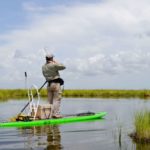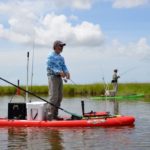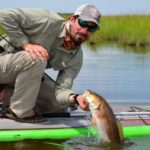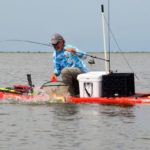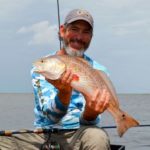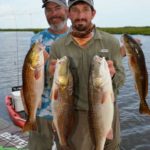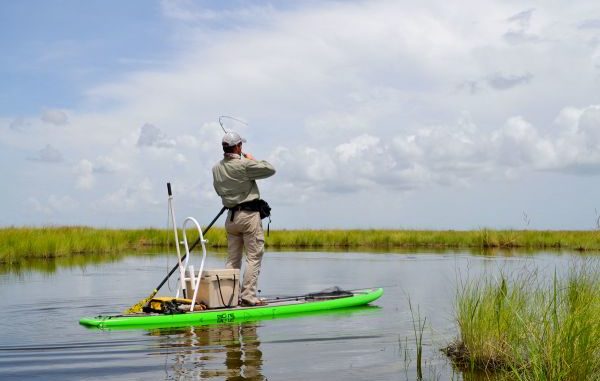
Kayaks have become all the rage in the fishing community, but chasing redfish from paddle boards takes it one step farther. Learn how this guide mother-ships boards to the Theriot marsh and slams shallow reds.
At first I thought they looked silly. I mean, c’mon — two guys standing on surf boards fishing in the marsh.
It sure wasn’t the guys that looked out of place. They were lean, rugged, suntanned outdoor types, both wearing full beards.
It was, er, their boats. I guess you call them boats.
The senior of the pair at 53 was John Williams, owner of Pack & Paddle in Lafayette, which specializes in hiking, kayaking and paddling equipment, clothing, footwear and accessories.
The younger one, Justin Head, is a full-time Baptist minister and part-time charter fishing guide (Headntails Fishing Charter, 337-280-4932) based out of Theriot.
I had spent the previous evening cooking with Head and his wife Jessica (see this month’s Louisiana Seafood Bible column).
The silly factor disappeared quickly when a big redfish smashed Williams’ lure less than 20 feet from his board. The 16-inch deep water boiled, and spray flew as high as Williams’ face.
It looked like a shark attack; it was violent.
This whole trip started, as so many do, with a casual conversation. I consider Williams to be a friend, as well as my kayak mentor. His store handles 10 brands of kayaks and paddle boards in 45 styles, as well as canoes. He knows fishing too, averaging 50 to 60 days a year in a kayak chasing redfish, speckled trout and flounders.
Too few people see a kayak as complimentary to a powerboat rather than an alternative to one, he lectured. Kayaks have a stealth advantage and can get to great locations that fishermen in powerboats can see but can’t get to.
The one advantage powerboats have is that they can access remote locations.
“Mother-shipping is a growing thing,” Williams said. “You can use your own or a friend’s powerboat, or a guide who does mother-shipping to carry kayaks to those remote locations and then fish from the kayaks.”
But kayaks aren’t the only option, as I was learning.
“Paddle boards are ideal for mother-shipping,” Williams said. “They are smaller, so you can fit four of them in a bay boat compared to only two regular kayaks.”
Paddle boards, he explained, are — in simplest terms — oversized surf boards on which you can stand. Because the angler can stand on them, they are great sight-fishing platforms.
On the other hand, kayaks large enough to stand comfortably in are very large, he added.
“Paddle Boards are very stable. Some people assume that they would be shaky or tippy, but that is not the case,” Williams said. “This is especially true for those designed for fishing.”
I must have shown enough interest to encourage him, because he said he knew a fishing guide in Terrebonne Parish who offered mother-shipping trips for kayak and paddle-board fishermen, as well as powerboat trips. He asked me if I wanted to go.
Duh?
Head was the guide, and it turned out Williams knew him much more than casually. A few years ago, Williams started an outdoors circle in the youth group of the Lafayette church at which Head worked.
Head took on being an outdoors leader. Later he went on to work in sales part time for two years at Pack & Paddle.
When the appointed day of our trip arrived, Williams turned up with three small craft.
The 11-foot, 7-inch Jackson SUPerFISHal and the 12-foot Bote were both paddle boards.
Since I wasn’t brave enough to spend the day standing on a paddle board with a camera, the Pack & Paddle loaner he supplied for me was a Jackson Cruise 12, a conventional sit-on-top kayak. I was tickled with my ride.
Head piloted the bay boat out Bayou DeCade to a marsh area he described as being “very, very, very low salinity.” Their targets were small lagoons (duck ponds in Louisiana lingo) set off the bayou.
The plants on the bank — both in the bayou and the ponds — were brackish water wiregrass, but the dense vegetation in the water was primarily eel grass, with some water milfoil mixed in.
Both are freshwater species. The plants were heavily crudded over with algae.
“My strategy,” Head explained, “is to fish lake edges on a rising tide. As the water comes up, redfish probe the bank feeding in newly flooded areas. On falling tides, I fish in small ponds up in the marsh.
“Then the fish are feeding on crabs and bait species pulled out of the grass by the tide’s currents.”
Each man rigged two rods. Head’s rods held a 1/8-ounce copper spoon and a small white SPRO frog. Williams rigged up with a feathered copper spoon on one rod and a black-and-chartreuse soft-plastic Wedgetail Mullet on a weedless jighead on the other.
While they got prepared, Williams talked more about paddle board fishing.
“One of the hardest things to learn in paddle board fishing is controlling the board, especially in windy conditions,” he said. “Make use of the anchor or wedge the bow of the board up into the marsh grass to keep it from drifting.
“A good thing about paddle-board or kayak fishing is that you can park next to a bank and retrieve along the bank. In a bay boat, you are casting at right angles to the bank and the lure is in the red zone for only a short part of each cast.”
The pair began working the duck ponds as a team to position one board or the other for the perfect cast to any fish sighted in the 18-inch-deep water.
“I see one ahead in all that grass,” Head sang out.
He put down the rod with the spoon and picked up the other one rigged with the topwater frog.
A 3-pound red smashed the lure —and as small it was, it immediately proceeded to tow the board in circles until Head stabbed the anchor in the mud.
After landing the fish he grinned.
“I recently saw a story that redfish can’t feed on top of the water because of where their mouths are located,” Head said. “This one didn’t know that.”
Although this fish came out of a dense grass bed, Head explained that the best areas for fishing were open water between the grass beds and the shoreline.
“If it is solid grass, you can’t get your bait to the fish,” he explained.
As he was speaking, a redfish swam lazily between the two boards that were positioned just 20 feet apart.
Head pointed it out to Williams, who tossed a lure to it. The fish swiped at it, but didn’t take it.
“Drop it back; drop it back,” Head coached.
The big red took the lure a foot from the paddle board, and immediately broke off on the short line.
The mother-shipping guide explained paddle board placement and lure retrieval strategies.
“When you see a redfish, try to place the board so that the retrieve will not be straight on to the front (what Head calls the suicide approach) or from directly behind the fish (the kamikaze approach),” Head said. “Neither is natural.
“Try to get the retrieve to cross the fish’s path at an angle. If the fish is coming straight on, cast the bait and let it lie on the bottom ahead of it; when the fish is in striking distance, pick up the bait to trigger a strike.”
Head quickly spotted another one and shot a copper spoon across its path. The fish ate the lure, and the guide was soon admiring the 22-incher.
“That’s the right size to eat,” he said. “Too big and they aren’t as good; too small, there’s not enough meat.”
He unhooked the spoon and held it up.
“I prefer a copper spoon rather than a gold one up in the marsh, especially if it is cloudy or if the water is less than clear,” Heard said. “On sunny days or in clear water I prefer gold.”
Williams was hooking as many fish as Head — he just wasn’t landing them.
“Oh no,” he moaned, as he lost his third redfish in a row, one that was visibly tailing in the shallow water and that he had stalked for 50 yards.
But, five minutes later, he joined Head in putting meat in his ice chest — a bruiser over 27 inches long.
A morning squall closed in on the fishermen, so they paddled back to the powerboat, loaded up the boards and ran to a nearby camp to sit on the porch and eat a sandwich while it rained.
When it cleared up, Head suggested trying in Bayou DeCade itself. He buzzed the big boat on the shoulders of the bayou, looking for wakes made by spooked redfish in the shallows.
“Yup, they’re here,” he declared. “Redfish are patternable. The same banks hold fish year after year. I don’t know why, but they do.”
They anchored the big boat, launched their boards and were soon stalking the shallows. Compared to the kayak I was in, the paddle boards seemed to skim over the water’s surface.
This time, it was Head’s turn to lose a fish. He spied a red and shot the spoon across the front of it, and the fish quickly accepted the lure.
Almost instantly, the fish popped the 20-pound-test leader.
While Head retied, Williams saw two or three reds moving together.
Crash — patunk.
A 6-pounder slammed his lure hard and put on a spectacular, splashing show in the shallows.
The fish hit so hard and so quickly that Williams missed the taco on his belt clip with the shaft of the paddle. As the dropped paddle floated off, Head laughed hugely before retrieving it for his partner.
Head paddled a little farther and jumped another churning school of fish. He quickly whacked a 4-pounder, and the rest of the school scattered.
After that fish, the reds got larger and their feeding activity became more aggressive. One seemed to follow the other.
It really was cool to see a fish’s bow wake, cast 20 feet to it and watch the smash.
The men began to release some of the larger fish, hoping to catch smaller ones. It was a cat-and-mouse game, with the anglers almost laying their lures on the fish’s noses.
Sometimes the casts were only 10 feet. The savagery of their fights in the shallow water was startling.
But the violence wasn’t all in the water; in the distance, a solid wall of threatening blue clouds loomed. Head volunteered to paddle back down the bayou to retrieve the big boat.
Williams kept fishing, and quickly hit his limit. But he kept fishing for fun, releasing the fish.
Head seemed to be taking a long time, and the wall of ugly weather was closing in. Finally, the boat rounded the bend in the bayou.
Head wore a guilty grin.
“When I got close to the boat,” he admitted, “there were redfish everywhere — big ones. I caught three, and there’s the last one.”
He pointed to a hefty 10-pounder lying in the bottom of the boat, flaring its gill covers.
We got wet on the ride in.
